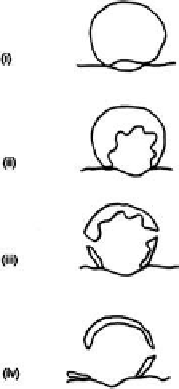Geology Reference
In-Depth Information
part. Here, dew may form, or the vapour respired by small mammals that find shelter in the
crevices and hollows may be condensed.
The question is however more complex. For instance, chlorine is present in several British gran-
ites (Thomson, 1863), and of the areas examined chlorine attains its highest concentration in the
granites of southwestern England. Yet, neither there nor elsewhere in Britain are true tafoni in evi-
dence. Possibly in humid climates salts are washed through the system before they can cause rock
disintegration. It is also difficult to understand how salt in concentration no greater than 0.5% can
create high porosity in otherwise fresh rock and cause it to rupture.
10.4.2.3
The nature of visor/outer shell
By definition, it is critical to the formation of tafoni, for it differentiates enclosed tafoni from open
alcoves and shelters, but it is difficult to explain. Flaking and disintegration wear away and even-
tually breach the pendant slab from the inside, suggesting that whatever has protected the
visor/outer shell is to be found on the outer surface. For Wilhelmy (1964) the visor/outer shell
merely reflects an outer skin of rock that has been dried and thus hardened. Certainly, thin surfi-
cial zones, lacking any discernible alteration, but nevertheless clearly more resistant than those
immediately below them, have been noted in the field. Alternatively, there are many examples, and
not only in granitic rocks, of secondary mineralisation having taken place along fractures, with salts
having precipitated out from circulating groundwaters. Such impregnations could account for some
hardened outer zones of blocks and hence for visors. But the outer casing is breached more and
more and, and it is eventually eliminated, so that the distinction between tafoni and alcoves is in
granite terrains evolutionary (see below); though elsewhere, as in limestone and sandstone, alcoves
are genetically different from their granitic counterparts. In other cases, especially areas of wet cli-
mate, the external zone of the block is covered by a mostly continuous layer of lichens.
10.4.3
Stages of development
The vast majority of tafoni starts from fracture planes whatever their orientation (
Fig. 10.8)
.
Some
few are apparently initiated on weathered or eroded surfaces such as flared slopes, possibly on
xenoliths of more readly weathered mafic minerals, but a fracture plane is a much more common
starting point. The first stage (i) starts when hollows form on both sides of the fracture plane
(Fig.
8.12b).
In general, however, the hollow in the upper block is larger than that in the lower
(Fig. 10.9),
the reasons of these differences are evident when the starting surface is horizontal.
Weathered bedrock, due either to haloclastic flaking, granular disintegration or other, falls on to
Figure 10.9.
Suggested stages in development of tafone.


